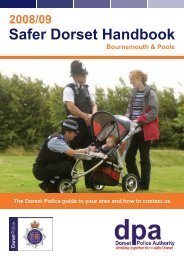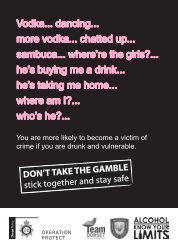No safer place to live in England - Dorset Police
No safer place to live in England - Dorset Police
No safer place to live in England - Dorset Police
You also want an ePaper? Increase the reach of your titles
YUMPU automatically turns print PDFs into web optimized ePapers that Google loves.
Eastern<br />
Crime isn’t HALF what it used <strong>to</strong> be!<br />
In this modern world of 24-hour media, tabloid journalism and<br />
s<strong>to</strong>ries of ‘yob culture’ it is easy <strong>to</strong> believe that crime is on the up<br />
and up - that we have more reason <strong>to</strong> fear becom<strong>in</strong>g a victim of<br />
crime than ever before.<br />
Eastern Division ran a publicity campaign at the end of 2006 show<strong>in</strong>g how<br />
crime <strong>in</strong> all areas has decreased dramatically s<strong>in</strong>ce 1998. The campaign’s<br />
newspaper advertisements were paid for by the Proceeds of Crime.<br />
Perhaps that is true of some areas of the UK but it is certa<strong>in</strong>ly<br />
NOT the case <strong>in</strong> Eastern Division of <strong>Dorset</strong> <strong>Police</strong>. In<br />
Christchurch, East <strong>Dorset</strong>, <strong>No</strong>rth <strong>Dorset</strong> and Purbeck crime has<br />
fallen dramatically s<strong>in</strong>ce 1998, the year that Eastern Division <strong>in</strong> its<br />
current geography was formed and also the year<br />
that the Crime and Disorder Reduction<br />
Partnership (CDRP) was created.<br />
Compar<strong>in</strong>g last year’s crime figures with those<br />
recorded <strong>in</strong> 1998 reveals an unprecedented fall <strong>in</strong><br />
levels of property crime.<br />
In 2006 <strong>in</strong> Eastern Division:<br />
●●● 470 fewer homes were burgled than <strong>in</strong> 1998<br />
●●● 1,000 fewer cars were broken <strong>in</strong><strong>to</strong>; and<br />
●●● 200 fewer cars were s<strong>to</strong>len.<br />
That’s an overall reduction of 55 per cent on<br />
1998 figures.<br />
So why has burglary and vehicle crime reduced<br />
so dramatically? Detective Chief Inspec<strong>to</strong>r Garrick<br />
Smith, Eastern Division’s Crime and Performance<br />
Manager, has some ideas:<br />
Public awareness<br />
People are far more aware of crime prevention<br />
than they were 10 years ago. This has meant that<br />
we are less likely <strong>to</strong> leave our homes and cars<br />
<strong>in</strong>secure or <strong>to</strong> leave valuables <strong>in</strong> an unattended<br />
vehicle. An important part of crime prevention is<br />
reduc<strong>in</strong>g the opportunities for thieves <strong>to</strong> steal,<br />
and home and car owners are <strong>in</strong>creas<strong>in</strong>gly aware<br />
of this.<br />
Technology<br />
There is little doubt that technological<br />
developments have contributed <strong>to</strong> the fall <strong>in</strong><br />
crime. Home security, for example, has improved<br />
and many new homes are now built with<br />
advanced security systems. Improvements <strong>in</strong> the<br />
design of re<strong>place</strong>ment w<strong>in</strong>dows and doors make<br />
break-<strong>in</strong>s more difficult - we are record<strong>in</strong>g an<br />
<strong>in</strong>creas<strong>in</strong>g number of <strong>in</strong>cidents where the<br />
‘would-be’ burglar has had <strong>to</strong> give up after<br />
try<strong>in</strong>g unsuccessfully <strong>to</strong> force several w<strong>in</strong>dows<br />
and doors.<br />
Advances <strong>in</strong> technology have also had a huge<br />
effect on vehicle crime. Ten years ago eng<strong>in</strong>e<br />
immobilisers were only fitted <strong>to</strong> luxury cars<br />
whereas now they are a standard fitt<strong>in</strong>g <strong>to</strong> most<br />
new cars, mak<strong>in</strong>g them more difficult <strong>to</strong> steal. If<br />
they are s<strong>to</strong>len, many cars now have track<strong>in</strong>g systems fitted so<br />
that the police can locate them wherever they are <strong>in</strong> the country.<br />
Enterta<strong>in</strong>ment systems are now <strong>in</strong>tegrated <strong>in</strong><strong>to</strong> car dashboards,<br />
mak<strong>in</strong>g them almost impossible <strong>to</strong> steal. Car parks are better<br />
designed and more secure than they were previously and the<br />
widespread use of CCTV has made it <strong>in</strong>creas<strong>in</strong>gly harder for<br />
thieves <strong>to</strong> operate without be<strong>in</strong>g detected.<br />
Cost of ‘luxury’ goods<br />
The retail cost of home electrical goods - TVs and DVD players,<br />
for example - has reduced dramatically <strong>in</strong> recent years. Many of<br />
the items that burglars used <strong>to</strong> steal from our homes now have<br />
such little second hand value that they are considered by thieves<br />
as ‘not worth steal<strong>in</strong>g’. Many crim<strong>in</strong>als have decided that, <strong>in</strong> terms<br />
of f<strong>in</strong>ancial reward, domestic burglary is no longer worth the risk.<br />
Neighbourhood Watch<br />
The growth of Neighbourhood and Home Watch schemes means<br />
that many communities have become ‘no-go’ areas for burglars.<br />
Once a burglar has been caught as a result of a phone call from a<br />
Neighbourhood Watch they feel more vulnerable <strong>in</strong> that area and<br />
are not prepared <strong>to</strong> take the risk of gett<strong>in</strong>g caught aga<strong>in</strong>.<br />
Tougher sentences<br />
Sentenc<strong>in</strong>g policy has also changed, with the <strong>in</strong>troduction of<br />
manda<strong>to</strong>ry sentences for persistent offenders. Two decades ago<br />
the average sentence for a career burglar was 18 months <strong>to</strong> two<br />
years. <strong>No</strong>wadays it is not unusual <strong>to</strong> see persistent offenders<br />
receiv<strong>in</strong>g prison sentences of five years and more.<br />
Improvements <strong>in</strong> polic<strong>in</strong>g<br />
Our <strong>in</strong>telligence-led approach is about direct<strong>in</strong>g our resources<br />
<strong>to</strong>wards catch<strong>in</strong>g those crim<strong>in</strong>als who are committ<strong>in</strong>g the greatest<br />
volume of crime so that we can maximise the impact of their arrest.<br />
Catch<strong>in</strong>g and convict<strong>in</strong>g prolific and persistent offenders is central<br />
<strong>to</strong> our crime reduction strategy and we are gett<strong>in</strong>g better at it all<br />
the time.<br />
We are also mak<strong>in</strong>g greater use of technology <strong>in</strong> the fight <strong>to</strong><br />
reduce crime. One recent <strong>in</strong>novation has been the <strong>in</strong>troduction of<br />
‘capture cars’. These are ord<strong>in</strong>ary cars fitted <strong>in</strong>side with t<strong>in</strong>y video<br />
cameras that au<strong>to</strong>matically start record<strong>in</strong>g when the car is broken<br />
<strong>in</strong><strong>to</strong>. At the same time they send a text message <strong>to</strong> the police<br />
phone network, alert<strong>in</strong>g officers. These capture cars have led <strong>to</strong><br />
the arrest and conviction of numerous persistent car thieves.<br />
The use of the Au<strong>to</strong>mated Number Plate Recognition System<br />
(ANPR) is also <strong>in</strong>creas<strong>in</strong>g. These cameras, sited at the side of the<br />
road or <strong>in</strong> unmarked police vehicles, au<strong>to</strong>matically record and<br />
<strong>in</strong>stantly check car registration numbers aga<strong>in</strong>st the <strong>Police</strong><br />
National Database, as vehicles pass by. The system will <strong>in</strong>stantly<br />
identify s<strong>to</strong>len vehicles and vehicles known <strong>to</strong> be used by active<br />
crim<strong>in</strong>als and is an important <strong>to</strong>ol <strong>in</strong> identify<strong>in</strong>g and disrupt<strong>in</strong>g<br />
crim<strong>in</strong>als who travel through the Eastern Division committ<strong>in</strong>g<br />
crime. ANPR is now deployed regularly on all the ma<strong>in</strong> arterial<br />
routes across the <strong>Dorset</strong> <strong>Police</strong> area.<br />
What is the Crime and<br />
Disorder Reduction<br />
partnership (CDRP)?<br />
The Crime and Disorder Act 1998 made it a statu<strong>to</strong>ry<br />
requirement for councils, the <strong>Police</strong>, Primary Care Trusts, the<br />
Fire and Rescue Service, other key agencies and the community<br />
<strong>to</strong> work <strong>to</strong>gether at borough/district level <strong>to</strong> develop and<br />
implement plans for reduc<strong>in</strong>g crime and disorder.<br />
In Eastern <strong>Dorset</strong> (Christchurch, East <strong>Dorset</strong>, <strong>No</strong>rth <strong>Dorset</strong> and<br />
Purbeck), the requirements of the Act were met through the<br />
formation of the Eastern Crime and Disorder Reduction<br />
Partnership (CDRP), which sees the area’s four borough/district<br />
authorities, <strong>Dorset</strong> County Council, Eastern Division of <strong>Dorset</strong><br />
<strong>Police</strong>, <strong>Dorset</strong> Fire and Rescue Service, Primary Care Trusts,<br />
Probation and Hous<strong>in</strong>g work<strong>in</strong>g <strong>to</strong>gether <strong>to</strong> address crime issues<br />
across the Eastern polic<strong>in</strong>g division, and on a local level by<br />
work<strong>in</strong>g with local action and community groups.<br />
The 1998 Act also requires local authorities <strong>to</strong> consider the<br />
impact of all of their functions on crime and disorder issues.<br />
As part of their commitment <strong>to</strong> do<strong>in</strong>g so, each of the four<br />
Eastern <strong>Dorset</strong> authorities has a full-time officer dedicated <strong>to</strong><br />
tackl<strong>in</strong>g Community Safety who works closely with the police<br />
and other partners.<br />
They are:<br />
●●● Christchurch: Natalie Murray (01202 495111)<br />
●●● East <strong>Dorset</strong>: Martha Perry (01202 639032)<br />
●●● <strong>No</strong>rth <strong>Dorset</strong>: John Bartlett (01258 484368)<br />
●●● Purbeck: Karen Jaggs (01929 557387)<br />
The Crime and Disorder Reduction Partnership has recently<br />
launch a new website, offer<strong>in</strong>g the latest news and <strong>in</strong>formation<br />
on the good work the partnership is <strong>in</strong>volved <strong>in</strong>. For any further<br />
<strong>in</strong>formation on the partnership, please visit<br />
www.dorsetwork<strong>in</strong>g<strong>to</strong>gether.org<br />
Two of Eastern <strong>Dorset</strong> CDRP’s four full-time<br />
Community Safety Officers are Martha Perry<br />
(East <strong>Dorset</strong>) and Karen Jaggs (Purbeck).<br />
15











